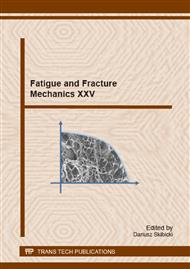[1]
Karolczuk A., Kowalski M., Bański R., Żok F., Fatigue phenomena in explosively welded steel–titanium clad components subjected to push–pull loading, Int. J. Fatigue 48, 2013, 101–108.
DOI: 10.1016/j.ijfatigue.2012.10.007
Google Scholar
[2]
Karolczuk A., Kowalski M., Structural and fatigue properties of titanium-steel bimetallic composite obtained by explosive welding technology, Key Engineering Materials 592-593, 2014, 594-597.
DOI: 10.4028/www.scientific.net/kem.592-593.594
Google Scholar
[3]
Kurek A., Nieslony A., Fatigue life tests of explosively cladded steel-titanium bimetal, Materials Science Forum 726, 2012, 106-109.
DOI: 10.4028/www.scientific.net/msf.726.106
Google Scholar
[4]
Karolczuk A., Kluger K., Kowalski M., Żok F., Robak G., Residual stresses in steel-titanium composite manufactured by explosive welding, Materials Science Forum 726, 2012, 125-132.
DOI: 10.4028/www.scientific.net/msf.726.125
Google Scholar
[5]
Karolczuk A., Kowalski M., Kluger K., Żok F., Identification of residual stress phenomena based on the hole drilling method in explosively welded steel-titanium composite, Archives of Metallurgy and Materials 59/3, 2014, 1129-1133.
DOI: 10.2478/amm-2014-0195
Google Scholar
[6]
Kluger K., Lagoda T., New energy model for fatigue life determination under multiaxial loading with different mean values, Int. J. Fatigue 66, 2014, 229–245.
DOI: 10.1016/j.ijfatigue.2014.04.008
Google Scholar
[7]
Kluger K., Łagoda T., Fatigue life of metallic material estimated according to selected models and load conditions, J. Theor. Appl. Mech. 51, 2013, 581-592.
Google Scholar
[8]
Skibicki D., Multiaxial fatigue life and strength criteria for non-proportional loading Materialprufung 48/3, 2006, 99-102.
DOI: 10.3139/120.100717
Google Scholar
[9]
Barnat W. Experimental and numerical study of influence of incidence angle of shock wave created by explosive charge on the steel plate, Bulletin of the polish academy of sciences-technical sciences 62/1, 2014, 151-163.
DOI: 10.2478/bpasts-2014-0017
Google Scholar
[10]
Prażmowski M., Paul H., The effect of stand-off distance on the structure and properties of zirconium – carbon steel bimetal produced by explosion welding, Archives of Metallurgy and Materials 57/4, 1201–1210.
DOI: 10.2478/v10172-012-0134-0
Google Scholar
[11]
Walczak W., Zgrzewanie wybuchowe metali i jego zastosowanie, WNT, Warszawa 1989 (in Polish).
Google Scholar


